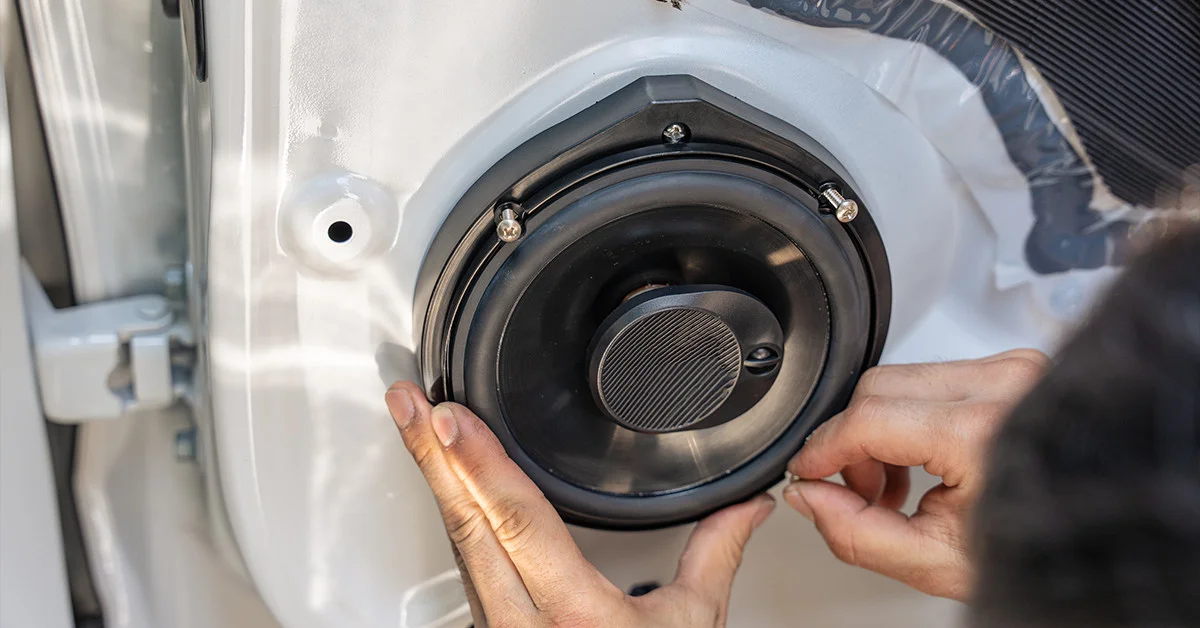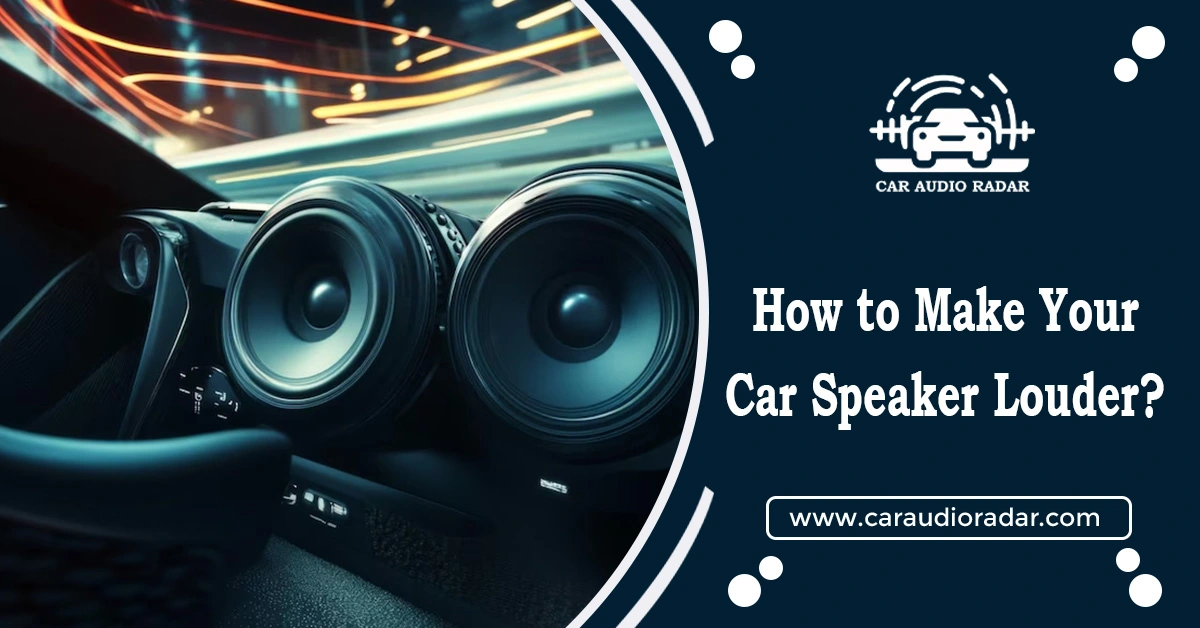
Jump to
Shall I Install a Car Speaker By Myself? Step-By-Step Methods

Shall I Install a Car Speaker By Myself? Is It Safe? These are the most common questions. Most factory car speakers could be more powerful, so people often replace them. If you want to install speakers in your car independently or want to replace old speakers. You need to do some research first. You might damage your car or the new speakers if you don’t.
The instructions that come with the speakers usually tell you how to put them together, not how to install them in your vehicle. But if you’ve done your homework, it’s pretty easy to do, and you don’t need to be a tech expert or have previous experience. In this article, we’ll give you step-by-step instructions on the installation of an audio system.
What Are Car Speakers?
Car speakers turn signals into sound. They make sounds in your home, car, or even the airport for announcements. Cars have different sizes and kinds of speakers, each for different types of sounds.
Types of Car Speakers
Usually, there are four main types of speakers you can buy:
- Tweeter: A small speaker for high-pitched sounds.
- Driver: A medium-sized speaker for clearer sound.
- Woofer: A larger speaker for deeper sounds in the lower range.
- Subwoofer: A big speaker for booming bass.
Install a Car Speaker By Myself: DIY installation
Basics of Car Speakers
- Time Needed: 1-2 hours (can vary)
- Skill Level: Novice
- Part of Car: Electrical System
Car Speaker Installation
Installing car speakers is easy and takes about an hour or less. But make sure to be careful during installation to avoid damaging anything.
Causes of Speaker Damage
Installing speakers properly can avoid getting damaged, cost you more money, and possibly cause damage. Here are some common reasons speakers get damaged:
- Magnetic coil damage
- Short circuits
- Fuse damage
- Cracks in the cone
Tools Needed for Installing Car Speakers
When installing new car speakers, it’s important to have the right tools to do the job without damaging your car’s parts. While the tools you need might vary depending on your car, there are some basic ones you’ll likely need:
- Hex keys
- Crimping tools
- Phillips screwdriver
- Flashlight
- Electrical tape
- Panel removal tool
- Knife (for cutting putty or foam)
- Retaining clip puller
- Soldering iron
- Small metric and inch sockets
- Screws
- Drill with Phillips bits
- Torx hand tools
- Angled and flat-lifting tools
- Socket wrench
- Wire stripper and cutter
- File (if needed)
Parts needed
- New car speakers
- Additional speaker wire
However, car speaker installation may sometimes be much simpler than others. This mainly depends on the speakers’ locations and the methods required to access them.
Speakers are often in the door panel, while some are in the dashboard, on the parcel shelf, or within the car’s rear ends. To replace some speakers, you may need to remove the door trim. Others may be much simpler. You’ll have to check for yourself or hire a pro.
Car Speaker Wiring Harness
The first thing you’ll need is a wiring harness for your car. It has a plastic connector at the end of the speaker cable, making it easy to connect your new speakers without cutting wires or soldering.
Speaker Stands or Adapters
You’ll also need adapters or speaker stands. These come in handy if your new speakers aren’t the same size as the original ones. They help with mounting and alignment.
Check your stock speakers’ sizes if you need clarification on whether you need mounting brackets without removing the door trim. If they’re 6.5″, 6×9″, 5×7″, or 6×8″, you might not need them as these are common sizes for aftermarket speakers too.
How to Install a Car Speaker By Myself
The size of the car speakers is the most important factor to think about when choosing them. You need to get ones that fit your car’s make and model. The installation of car speakers depends on where the factory speakers are, how high and deep they’re mounted, and the car’s wiring.
Installation steps
- Start by disconnecting the car’s battery.
- Remove panels, grilles, and covers to find the speakers. You might need a tool like a screwdriver to do this. Sometimes, the speakers are in tricky spots like under seats.
- Take out the old speakers, but remember how they were connected with wires and screws in case you need to put them back or sell them.
- Reconnect the battery and test the sound with the new speakers. This saves you from having to redo everything if there’s a problem.
- After testing, disconnect the battery again and finish screwing or mounting the new speakers securely.
- If you want to install subwoofers or give more power to the speakers, you might need extra steps or an amplifier.
Different Methods to Install and Replace Car Speakers
Method 1: Replacing Dash Speakers
- Some cars have speakers on the dashboard, which you can replace yourself.
- You’ll need a 90-degree screwdriver to reach the screws by the windshield.
- Removing dash speakers is easy take off the grilles held down by screws or friction fittings.
- Use a panel tool to remove the grilles without scratching or cracking the dashboard carefully.
- Sometimes, you may have to take off the entire dashboard panel to swap out the speakers, especially if the grilles are held in place by screws or plastic studs that might break.
- After removing the old speakers, use a wiring harness to connect the new ones to the system.
- Secure the connections with electrical tape to protect them from temperature changes and extreme weather, which can damage the wiring over time.
Method 2: Replacing Rear Speakers
- Changing rear speakers can differ depending on the car, but it’s usually straightforward.
- Just pry off the grilles and swap the speakers.
- You might need to fold down the back seats in some cars to access the speakers.
- In other cases, you may have to remove the entire interior panel from the rear deck.
Method 3: Replacing Door Speakers
- You must remove the front door panels using a screwdriver or tool to replace the door speakers.
- Some screw locations might be hard to find, like behind door handles or under covers.
- Carefully use a flathead screwdriver to gently separate the panels from the door, or use a special panel tool to remove the door handles.
- Disconnect any wiring you come across, such as for power door locks.
- Installing car speakers is pretty straightforward. It’s best to replace both pairs of speakers, not just one.
- Unscrew the speaker and take it out from the door.
- Attach the positive and negative wires to the speaker as directed in the instructions.
- Secure the wires with a zip tie and trim any excess with flush-cut pliers to avoid damage from power windows.
- Reconnect the battery, turn on the ignition, and check if the new speakers work.
- If there’s any issue, troubleshoot before putting the door panel back on, following the reverse of the removal instructions.
Method 4: Replacing Speakers on the Parcel Shelf
- Start by removing the old speakers. You can usually access them through the car’s trunk and unscrew them.
- Once the old speaker is out, you can install the new one.
- When choosing new speakers, ensure they’re the right size and can handle the power from your car’s audio system.
- Consider the type of speaker, like coaxial or component, and what they’re made of.
- After installing the new speakers, test them to ensure they work properly.
- Play music at different volumes to check for distortion or other problems.
- Also, check the wiring to ensure it’s connected correctly and securely.
How to Choose the Right Car Speakers
- Stick to the same brand, size, and series of speakers throughout your car for a uniform sound.
- If you’re on a budget, replace the front speakers first, then move to the rear, side, and additional speakers.
- Always match brand, wattage, and series for consistent sound quality.
- High-sensitivity speakers (over 90 decibels) are good for factory power systems. They use less than 15 watts per channel.
- Aim for 75 watts or less per channel for better sound quality if using an aftermarket stereo.
- Ensure the RMS wattage of your aftermarket amp matches your speakers. Check the unit or user manual for specs.
Common Challenges When Installing Car Speakers
Wrong Mounting
Speakers need to be mounted properly to avoid rattling and ensure good sound. Take time and correctly secure the mounting bracket, wiring, and speaker.
Forgetting to Turn Off the Power
This is dangerous and can cause wiring shorts. Always disconnect the power from your car and sound system before starting.
Speaker Compatibility
Ensure the new speakers fit your car and can work with your electrical system and audio setup before buying them.
Polarity Mix-up
Mixing up positive and negative wires is a common mistake. Check that they’re properly labelled before installing them to avoid damage.
Damaging Wire Harness
Don’t rip or yank the wiring harness out of its connection. Release any locking tabs before removing them to avoid permanent damage.
Dos and Don'ts for Installing Speakers
Dos
- Always disconnect the battery before using any wiring, even basic audio/visual cables.
- Test-fit your speakers before removing all grills, framing components, or door covers.
- Before installing a subwoofer, ensure you have the right amplifier to avoid extra costs.
Don'ts
- Don’t hesitate to contact a licensed aftermarket speaker installation expert for advice on installing your chosen speakers.
Dos
- Always disconnect the battery before using any wiring, even basic audio/visual cables.
- Test-fit your speakers before removing all grills, framing components, or door covers.
- Before installing a subwoofer, ensure you have the right amplifier to avoid extra costs.
Expert Tips for Installing Car Speakers
- Always test-fit the speaker before installing it to ensure it’s the right fit.
- Installing subwoofers will be different and may require a standalone amplifier, which adds extra costs.
- Consider getting a new head unit and replacing speakers for a better audio system.
- Despite doing research, it’s wise to test the speaker before installation.
- Installing subwoofers involves additional steps and costs for the amplifier.
- Replacing speakers can enhance your vehicle’s sound system, but you might need to replace the head unit for the full audio experience.
Pros and Cons of Installing Speakers by Yourself
Pros
- The cost-effective improvement you can make by Doing it yourself.
- Installing speakers alone is a chance to learn about your car’s audio system.
- You get to pick the speakers you want and install them how you like.
- You can work independently without waiting for a professional.
Cons
- The cost-effective improvement you can make by Doing it yourself.
- Installing speakers alone is a chance to learn about your car’s audio system.
- You get to pick the speakers you want and install them how you like.
- You can work independently without waiting for a professional.
Conclusion
In Conclusion, putting in or changing your car’s speakers is pretty easy. Every car has its way of installing speakers. Take your time, read the instructions, and gather all your tools before you start. With the right tools, You can install speakers in about an hour or less. But if you need to be more confident, it’s best to get a professional to do it for you. If you follow our guide on Shall I Install a Car Speaker By Myself? You should be able to do it without a problem.
Frequently asked Questions (FAQs)
Yes, you can install car speakers if you’re comfortable with DIY projects and have the necessary tools. However, seeking professional help is best if you need more clarification or experience.
First, make sure they’re the right size. Even the best speakers will only work if they fit. It’s a hassle to modify your car to make them fit. Once you’ve got the size right, think about the speaker’s features, like power, how they’re installed, and the price.
Yes, you can add speakers to your car. Various options include door speakers, rear shelf speakers, and custom installations.
You can add sound-deadening materials inside the door panels to make your car door speakers sound better. This helps to contain the sound within the car instead of letting it out. Also, installing new gaskets for each speaker is a good idea. They prevent loose parts from rattling or making noise.
Yes, speakers in a car can be replaced. If you’re experiencing issues with your current speakers or want to upgrade to better ones, replacing them is a common solution.
Yes, you can, but it won’t work as well. You’ll have to figure out the wiring, and you’ll need to find a way to install the speakers in your car securely so they don’t move around. It’s better to use speakers made specifically for cars.
The cost of installing speakers in a car can vary depending on factors like the quality of speakers, labor charges if you hire a professional, and any additional materials needed for installation. Generally, it can range from a few hundred to a few thousand dollars.
The overhead storage compartment is the best spot for a Bluetooth speaker in your car. It gives the speaker a good sound and is easy for the driver and passenger to reach.
Other places will work if you can’t put the Bluetooth speaker in the overhead compartment. You can attach it to the sun visor, under the seat, or in the center console.
Cooper Katzeel
Car Enthusiast
Cooper Katzel, a dedicated car enthusiast, delves into the world of automobiles and audio systems. With a deep interest in cars and a focus on superior sound, Cooper’s expertise traverses the spectrum. His journey is a delightful exploration of automotive wonders and the world of car speakers. Cooper’s passion and technical know-how make him a trusted advisor for car enthusiasts.
Follow On Instagram
Recent Posts
- All Post
- Blog
- Car Speaker
- Car Subwoofer
- Pro Tips & Guides
- Back
- Speaker Wire



Dream Life in Paris
Questions explained agreeable preferred strangers too him her son. Set put shyness offices his females him distant.


